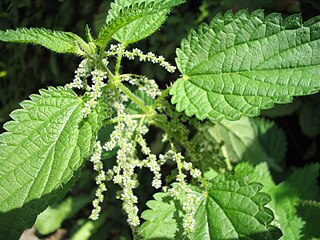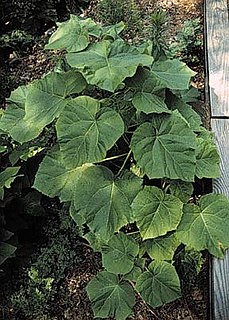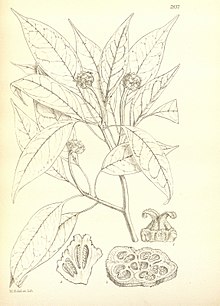
The Saxifragales (saxifrages) are an order of flowering plants (Angiosperms). They are an extremely diverse group of plants which include trees, shrubs, perennial herbs, succulent and aquatic plants. The degree of diversity in terms of vegetative and floral features makes it difficult to define common features that unify the order.

Gnetophyta is a division of plants, grouped within the gymnosperms, that consists of some 70 species across the three relict genera: Gnetum, Welwitschia, and Ephedra. Fossilized pollen attributed to a close relative of Ephedra has been dated as far back as the Early Cretaceous. Though diverse in the Early Cretaceous, only three families, each containing a single genus, are still alive today. The primary difference between gnetophytes and other gymnosperms is the presence of vessel elements, a system of conduits that transport water within the plant, similar to those found in flowering plants. Because of this, gnetophytes were once thought to be the closest gymnosperm relatives to flowering plants, but more recent molecular studies have brought this hypothesis into question.

Droseraceae is a family of carnivorous flowering plants, also known as the sundew family. It consists of approximately 180 species in three extant genera. Representatives of the Droseraceae are found on all continents except Antarctica.

The Urticaceae are a family, the nettle family, of flowering plants. The family name comes from the genus Urtica. The Urticaceae include a number of well-known and useful plants, including nettles in the genus Urtica, ramie, māmaki, and ajlai.

Hamamelidaceae, commonly referred to as the witch-hazel family, is a family of flowering plants in the order Saxifragales. The clade consists of shrubs and small trees positioned within the woody clade of the core Saxifragales. An earlier system, the Cronquist system, recognized Hamamelidaceae in the Hamamelidales order.

Paulowniaceae are a family of flowering plants within the Lamiales. They are a monophyletic and monogeneric family of trees with currently 7 confirmed species. They were formerly placed within Scrophulariaceae sensu lato, or as a segregate of the Bignoniaceae.

Phrymaceae, also known as the lopseed family, is a small family of flowering plants in the order Lamiales. It has a nearly cosmopolitan distribution, but is concentrated in two centers of diversity, one in Australia, the other in western North America. Members of this family occur in diverse habitats, including deserts, river banks and mountains.

Altingiaceae is a small family of flowering plants in the order Saxifragales, consisting of wind-pollinated trees that produce hard, woody fruits containing numerous seeds. The fruits have been studied in considerable detail. They naturally occur in Central America, Mexico, eastern North America, the eastern Mediterranean, China, and tropical Asia. They are often cultivated as ornamentals and many produce valuable wood.

Eusporangiate ferns are vascular spore plants, whose sporangia arise from several epidermal cells and not from a single cell as in leptosporangiate ferns. Typically these ferns have reduced root systems and sporangia that produce large amounts of spores
Semiliquidambar is a genus of plants, most recently treated in family Altingiaceae, though previously often treated in Hamamelidaceae. Recent research suggests that it may not be a true genus, but that the species normally treated within it are hybrids of other species of Altingiaceae; the taxonomy of that entire family is currently under review pending the results of molecular phylogenetic investigations

Symmeria is a genus of plants in the family Polygonaceae with a single species, Symmeria paniculata, distributed in North and South America as well as western Africa. It is morphologically variable and dioecious, with male and female flowers on separate individuals.

The basal angiosperms are the flowering plants which diverged from the lineage leading to most flowering plants. In particular, the most basal angiosperms were called the ANITA grade which is made up of Amborella, Nymphaeales and Austrobaileyales.
An alliance is an informal grouping used in biological taxonomy. The term "alliance" is not a taxonomic rank defined in any of the nomenclature codes. It is used for any group of species, genera or tribes to which authors wish to refer, that have at some time provisionally been considered to be closely related.

The spermatophytes, also known as phanerogams or phaenogams, comprise those plants that produce seeds, hence the alternative name seed plants. They are a subset of the embryophytes or land plants.

Jamesonia is a genus of ferns in the subfamily Pteridoideae of the family Pteridaceae. It now includes the formerly separate genus Eriosorus.
Liquidambar changii is an extinct species of sweetgum in the Altingiaceae genus Liquidambar. Liquidambar changii is known from Middle Miocene fossils found in Central Washington.
Quercus hiholensis is an extinct species of oak in the Fagaceae genus Quercus. Quercus hiholensis is known from Middle Miocene fossils found in Central Washington.
Shirleya is an extinct genus in the crape myrtle family, Lythraceae, which contains a single species, Shirleya grahamae. The genus and species are known from Middle Miocene fossils found in Central Washington.

Liquidambar acalycina, Chang’s sweet gum, is a species of flowering plant in the family Altingiaceae, native to southern China. Growing to 30–50 ft (9.1–15.2 m) tall by 20–30 ft (6.1–9.1 m) broad, It is a medium-sized deciduous tree with three-lobed maple-like leaves that turn red in autumn before dropping. It is monoecious, meaning that both male and female flowers appear on the same plant. The flowers are insignificant, yellow/green in colour, and are followed by small gum-balls that persist on the tree until winter. The wood exudes a sweet-smelling resin when pierced, giving the tree its common name.
Jun Wen is an evolutionary biologist and curator at the Smithsonian's National Museum of Natural History in the Department of Botany and has worked in the Laboratory of Molecular Systematics. She researches the monography, phylogenetics, biogeography, and ethnobotany of the plant families Araliaceae and Vitaceae. She has published over 190 scientific papers.















